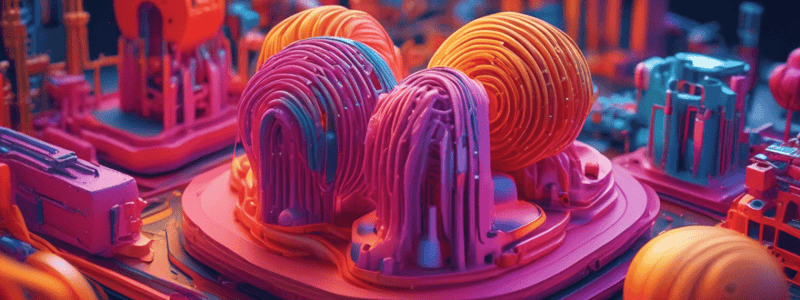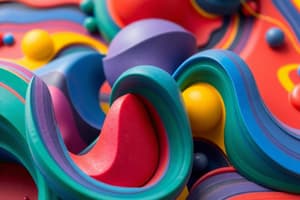Podcast
Questions and Answers
Where did the idea of layers in rapid prototyping and layer manufacture originate from?
Where did the idea of layers in rapid prototyping and layer manufacture originate from?
- First SLA systems by Charles Hull
- Population density map of Paris
- Mapping Contour plot (correct)
- Physical geography
Who was the first to apply the idea of contour plots to data?
Who was the first to apply the idea of contour plots to data?
- Buache
- Vauthier
- Charles Hull
- Léon Lalanne (correct)
What is the significance of the 1874 map of Paris by L.L.Vauthier?
What is the significance of the 1874 map of Paris by L.L.Vauthier?
- First published contour map by Buache
- First statistical use of a contour map (correct)
- Construction of 3D maps
- Introduction of SLA systems
Which system, proposed in 1956, has features similar to current stereolithography techniques?
Which system, proposed in 1956, has features similar to current stereolithography techniques?
What was the main contribution of Vauthier's map of Paris in 1892?
What was the main contribution of Vauthier's map of Paris in 1892?
Who is credited with constructing the first contour plot?
Who is credited with constructing the first contour plot?
When did 3D CAD first appear according to the text?
When did 3D CAD first appear according to the text?
What did 3D CAD allow in the 1990s according to the text?
What did 3D CAD allow in the 1990s according to the text?
What was one of the first commercial layered manufacturing systems enabled by 3D CAD in 1985 according to the text?
What was one of the first commercial layered manufacturing systems enabled by 3D CAD in 1985 according to the text?
What technology allowed SLA to become slightly later and cheaper after Chuck Hull's design according to the text?
What technology allowed SLA to become slightly later and cheaper after Chuck Hull's design according to the text?
What is a characteristic of some 'Upside down' SLA systems mentioned in the text?
What is a characteristic of some 'Upside down' SLA systems mentioned in the text?
What milestone has been reached today in terms of the number of 2D and 3D CAD models according to the text?
What milestone has been reached today in terms of the number of 2D and 3D CAD models according to the text?
What technology combined with 3D printing to enable a new phase in its growth?
What technology combined with 3D printing to enable a new phase in its growth?
In the past, how were most drawings produced?
In the past, how were most drawings produced?
What did CAD fundamentally change according to the text?
What did CAD fundamentally change according to the text?
What was the pivotal development period for new systems between 1985-1990?
What was the pivotal development period for new systems between 1985-1990?
How did making minor changes to drawings differ before the era of CAD?
How did making minor changes to drawings differ before the era of CAD?
Which technology was NOT mentioned as part of the first additive system that combined to create 3D data?
Which technology was NOT mentioned as part of the first additive system that combined to create 3D data?
What is the main difference between additive manufacturing and subtractive processes?
What is the main difference between additive manufacturing and subtractive processes?
What is a key advantage of additive manufacturing in terms of cost?
What is a key advantage of additive manufacturing in terms of cost?
What does the lecturer mention as one of the limits of any technology, including additive manufacturing?
What does the lecturer mention as one of the limits of any technology, including additive manufacturing?
Which term is NOT used as a synonym for additive manufacturing in the lecture?
Which term is NOT used as a synonym for additive manufacturing in the lecture?
What aspect makes additive manufacturing not 'quite free' according to the lecture?
What aspect makes additive manufacturing not 'quite free' according to the lecture?
What is mentioned as a downside regarding the cost in additive manufacturing?
What is mentioned as a downside regarding the cost in additive manufacturing?
Who was among the first to invent a single-beam laser curing approach for layered manufacturing?
Who was among the first to invent a single-beam laser curing approach for layered manufacturing?
In what year did Alain Le Mhaut, Olivier de Witte, and Jean Claude Andr file their patent for the stereolithography process?
In what year did Alain Le Mhaut, Olivier de Witte, and Jean Claude Andr file their patent for the stereolithography process?
What was the reason behind the abandonment of the French inventors' application for the stereolithography process patent?
What was the reason behind the abandonment of the French inventors' application for the stereolithography process patent?
Who defined the basic logic of an Additive layer system's operation through a patent?
Who defined the basic logic of an Additive layer system's operation through a patent?
What did DiMatteo recognize in 1974 about stacking techniques in layer manufacturing?
What did DiMatteo recognize in 1974 about stacking techniques in layer manufacturing?
What is the Glass Transition Temperature (Tg) in polymers?
What is the Glass Transition Temperature (Tg) in polymers?
What state of a polymer is characterized by it being brittle?
What state of a polymer is characterized by it being brittle?
Why do amorphous polymers like ABS have a wider melt processing window compared to crystalline materials like Nylons?
Why do amorphous polymers like ABS have a wider melt processing window compared to crystalline materials like Nylons?
What happens if the filament is printed too cold?
What happens if the filament is printed too cold?
In which state does a polymer exhibit softness and/or toughness?
In which state does a polymer exhibit softness and/or toughness?
What is the significance of the Melt Temperature (Tm) in polymers?
What is the significance of the Melt Temperature (Tm) in polymers?
What is the primary difference between Selective Laser Sintering (SLS) and Selective Laser Melting (SLM)?
What is the primary difference between Selective Laser Sintering (SLS) and Selective Laser Melting (SLM)?
In the context of Sheet Lamination, what role does the 'paper bulk additive layer' play?
In the context of Sheet Lamination, what role does the 'paper bulk additive layer' play?
What is a key factor influencing the surface finish in Selective Laser Melting (SLM)?
What is a key factor influencing the surface finish in Selective Laser Melting (SLM)?
What challenges arise in creating small features like holes using high power in additive manufacturing processes?
What challenges arise in creating small features like holes using high power in additive manufacturing processes?
Why is it complex to achieve precise details when looking closely at Selective Laser Sintering (SLS) parts?
Why is it complex to achieve precise details when looking closely at Selective Laser Sintering (SLS) parts?
What is a significant feature of Powder Bed Fusion processes like SLS and SLM?
What is a significant feature of Powder Bed Fusion processes like SLS and SLM?
What technology is used in Z-Corporation's printer to print fine patterns of glue onto a smooth bed of plaster powder?
What technology is used in Z-Corporation's printer to print fine patterns of glue onto a smooth bed of plaster powder?
Which system mentioned in the text uses a different powder-based approach where a binder compound is deposited on each layer of powder?
Which system mentioned in the text uses a different powder-based approach where a binder compound is deposited on each layer of powder?
What is a notable advantage of the AM process that Z-Corporation's printer uses?
What is a notable advantage of the AM process that Z-Corporation's printer uses?
Which method allows for the creation of full-color models with little postprocessing according to the text?
Which method allows for the creation of full-color models with little postprocessing according to the text?
Which category of ALM systems involves the use of wire arc additive manufacturing?
Which category of ALM systems involves the use of wire arc additive manufacturing?
What is a major limitation mentioned for Z-Corporation's printer in the text?
What is a major limitation mentioned for Z-Corporation's printer in the text?
What type of material is LAYWOO-D3, a 3D printing filament invented by Kai Parthy?
What type of material is LAYWOO-D3, a 3D printing filament invented by Kai Parthy?
Why is it mentioned that the FDM filament cannot cross itself in a given layer?
Why is it mentioned that the FDM filament cannot cross itself in a given layer?
Who are the inventors of the fused deposition modeling (FDM) technology?
Who are the inventors of the fused deposition modeling (FDM) technology?
What is the key parameter that determines the success of the FDM process according to the text?
What is the key parameter that determines the success of the FDM process according to the text?
What is the main reason mentioned in the text for a bad outcome in FDM due to cooling?
What is the main reason mentioned in the text for a bad outcome in FDM due to cooling?
What does understanding the process window for a CNC machine tool help determine according to the text?
What does understanding the process window for a CNC machine tool help determine according to the text?
What metals are currently available for Direct Metal Deposition (DMD) processes?
What metals are currently available for Direct Metal Deposition (DMD) processes?
What is the main function of the powerful laser in Direct Metal Deposition (DMD) systems?
What is the main function of the powerful laser in Direct Metal Deposition (DMD) systems?
What type of materials can be fabricated using Direct Metal Deposition (DMD)?
What type of materials can be fabricated using Direct Metal Deposition (DMD)?
What is one of the key parameters used for benchmarking in Additive Manufacturing?
What is one of the key parameters used for benchmarking in Additive Manufacturing?
What technology enables the creation of full-color models with little post-processing according to the lecture?
What technology enables the creation of full-color models with little post-processing according to the lecture?
What kind of diagrams are used for Additive Layer Manufacturing (ALM) processes according to the text?
What kind of diagrams are used for Additive Layer Manufacturing (ALM) processes according to the text?
What factor makes additive manufacturing an alternative to conventional machining for complex metallic parts?
What factor makes additive manufacturing an alternative to conventional machining for complex metallic parts?
In additive manufacturing technologies, what does the 'buy to fly ratio' refer to?
In additive manufacturing technologies, what does the 'buy to fly ratio' refer to?
Which factor can be used to estimate the energy required for FDM technology based on the provided formula?
Which factor can be used to estimate the energy required for FDM technology based on the provided formula?
What does the specific heat of the extruded material impact in FDM technology?
What does the specific heat of the extruded material impact in FDM technology?
What is a significant characteristic of ABS filament relevant to its use in FDM technology?
What is a significant characteristic of ABS filament relevant to its use in FDM technology?
What aspect of a part is assessed by examining the 'Thin Wall 1-3' benchmark in the SLS benchmark?
What aspect of a part is assessed by examining the 'Thin Wall 1-3' benchmark in the SLS benchmark?
In the SLS benchmark, what does the 'Rounded Corner' shape specifically evaluate?
In the SLS benchmark, what does the 'Rounded Corner' shape specifically evaluate?
Why does the benchmark shape need to reflect typical build volumes and accuracy ranges of systems being compared?
Why does the benchmark shape need to reflect typical build volumes and accuracy ranges of systems being compared?
What does the 'Cylinder 1-4' assessment in the SLS benchmark focus on?
What does the 'Cylinder 1-4' assessment in the SLS benchmark focus on?
Which aspect of a part is primarily evaluated by looking at the 'Sharp Corners' in the SLS benchmark?
Which aspect of a part is primarily evaluated by looking at the 'Sharp Corners' in the SLS benchmark?
Why are benchmarks built in multiple orientations according to the text?
Why are benchmarks built in multiple orientations according to the text?
How much energy is required for Selective Laser Melting (SLM)?
How much energy is required for Selective Laser Melting (SLM)?
What is the volume of material per second needed for the extrusion process?
What is the volume of material per second needed for the extrusion process?
What is the mass of material per second for the extrusion process?
What is the mass of material per second for the extrusion process?
What is the temperature change (T) during the extrusion process?
What is the temperature change (T) during the extrusion process?
What is the specific heat capacity (c) used in the extrusion calculations?
What is the specific heat capacity (c) used in the extrusion calculations?
How long does the build process take in seconds?
How long does the build process take in seconds?
Which company invented the STL file format in 1987?
Which company invented the STL file format in 1987?
What does CAD stand for in the context of the STL format?
What does CAD stand for in the context of the STL format?
What is the purpose of translating CAD models into STL before building on ALM systems?
What is the purpose of translating CAD models into STL before building on ALM systems?
What characteristic is mentioned about the STL file format?
What characteristic is mentioned about the STL file format?
What determines the quality of parts in relation to shape-only formats like STL?
What determines the quality of parts in relation to shape-only formats like STL?
What was the main reason behind the widespread adoption of STL as a general CAD exchange format?
What was the main reason behind the widespread adoption of STL as a general CAD exchange format?
What can help in printing longer bridges according to the text?
What can help in printing longer bridges according to the text?
What dictates the size and effect of the associated strains in RP processes?
What dictates the size and effect of the associated strains in RP processes?
In 3D printing, what feature size limit should be considered to avoid problems?
In 3D printing, what feature size limit should be considered to avoid problems?
Which parameter determines the maximum size of a component in ALM systems?
Which parameter determines the maximum size of a component in ALM systems?
What is defined as the absolute value of the deviation of the fabricated surface from the desired surface?
What is defined as the absolute value of the deviation of the fabricated surface from the desired surface?
Why does vertical build direction produce the best quality hole according to the text?
Why does vertical build direction produce the best quality hole according to the text?
Why is shielding necessary when using certain materials like titanium in metal 3D printing?
Why is shielding necessary when using certain materials like titanium in metal 3D printing?
What is the main limitation imposed by using an inert gas chamber in metal 3D printing?
What is the main limitation imposed by using an inert gas chamber in metal 3D printing?
What was the main idea behind Dr. Adrian Bowyer's RepRap movement and 'Crazy Fringe' in ALM?
What was the main idea behind Dr. Adrian Bowyer's RepRap movement and 'Crazy Fringe' in ALM?
What did Dr. Adrian Bowyer's team aim to create primarily using plastic in additive layer manufacturing?
What did Dr. Adrian Bowyer's team aim to create primarily using plastic in additive layer manufacturing?
What problem does residual stress in metal 3D printing often lead to?
What problem does residual stress in metal 3D printing often lead to?
How did the Replicating Rapid Prototyper Project envisioned by Dr. Adrian Bowyer differ from reality?
How did the Replicating Rapid Prototyper Project envisioned by Dr. Adrian Bowyer differ from reality?
What is the primary issue that large structures assembled from smaller parts to overcome build volume limitations face?
What is the primary issue that large structures assembled from smaller parts to overcome build volume limitations face?
In ALM processes, outcomes are highly dependent on which of the following factors?
In ALM processes, outcomes are highly dependent on which of the following factors?
Which manufacturing method results in models requiring labor-intensive finishing steps that can be as time-consuming as the initial manufacture?
Which manufacturing method results in models requiring labor-intensive finishing steps that can be as time-consuming as the initial manufacture?
What makes post processing in ALM expensive and labor-intensive?
What makes post processing in ALM expensive and labor-intensive?
Which finishing step in ALM can be as long as the actual manufacturing process due to its time-consuming nature?
Which finishing step in ALM can be as long as the actual manufacturing process due to its time-consuming nature?
What is a significant challenge faced by ALM systems despite overcoming build volume limitations?
What is a significant challenge faced by ALM systems despite overcoming build volume limitations?
How does Wire Arc Additive Manufacturing work?
How does Wire Arc Additive Manufacturing work?
What metals can Wire Arc Additive Manufacturing (WAAM) work with?
What metals can Wire Arc Additive Manufacturing (WAAM) work with?
What is a challenge associated with Wire Arc Additive Manufacturing?
What is a challenge associated with Wire Arc Additive Manufacturing?
Why is Wire Arc Additive Manufacturing (WAAM) not fully commercialized yet?
Why is Wire Arc Additive Manufacturing (WAAM) not fully commercialized yet?
What is one of the limitations mentioned for Wire Arc Additive Manufacturing?
What is one of the limitations mentioned for Wire Arc Additive Manufacturing?
Which companies are mentioned as collaborators working on the development of Wire Arc Additive Manufacturing?
Which companies are mentioned as collaborators working on the development of Wire Arc Additive Manufacturing?
What is a key difference between generative design and topological optimization?
What is a key difference between generative design and topological optimization?
What is a notable benefit achieved through the optimized design of a gearbox housing using ALM from a titanium alloy?
What is a notable benefit achieved through the optimized design of a gearbox housing using ALM from a titanium alloy?
Why is there significantly less uncertainty regarding the parts' composition and behavior under load when using generative design?
Why is there significantly less uncertainty regarding the parts' composition and behavior under load when using generative design?
What technology combination disrupted established ways of doing things according to the provided text?
What technology combination disrupted established ways of doing things according to the provided text?
What is a distinctive feature of generative design in terms of design exploration?
What is a distinctive feature of generative design in terms of design exploration?
What significant outcome results from implementing generative design in a gearbox housing's optimization process?
What significant outcome results from implementing generative design in a gearbox housing's optimization process?
Flashcards are hidden until you start studying
Study Notes
- Rapid prototyping and layer manufacture were attributed to Charles Hull, but the concept had been emerging for some time before he combined existing technologies in the first SLA systems.
- The idea of using layers in manufacturing was inspired by contour maps in geography, with the first statistical contour map published in 1843 by Léon Lalanne showing temperature variations.
- CAD (Computer-Aided Design) originated from engineering drawings around 100 years ago, with 2D CAD appearing in the 1980s and 3D CAD becoming more accessible in the 1990s for automated manufacturing systems.
- The concept of layered manufacturing dates back to 1974 when DiMatteo recognized the potential of stacking techniques for producing complex surfaces.
- The first additive manufacturing system in the 1980s combined material science, CNC movement control, and 3D data to lay the foundation for modern AM technologies.
- The evolution of ALM (Additive Layered Manufacturing) saw the development of various techniques like Vat photopolymerization, sheet lamination, powder bed fusion (SLS), selective laser sintering/melting, and binder jetting.
- ALM taxonomy categorizes seven generic categories of AM systems, with Vat photopolymerization being one of the earliest techniques that later led to alternative SLA-based systems with improved accuracy and cost-effectiveness.
- The development of ALM systems between 1985-1990 was driven by a combination of technological advancements, including the integration of material science, CNC control, and 3D data, leading to the commercialization of SLA systems and other AM technologies.
Studying That Suits You
Use AI to generate personalized quizzes and flashcards to suit your learning preferences.




